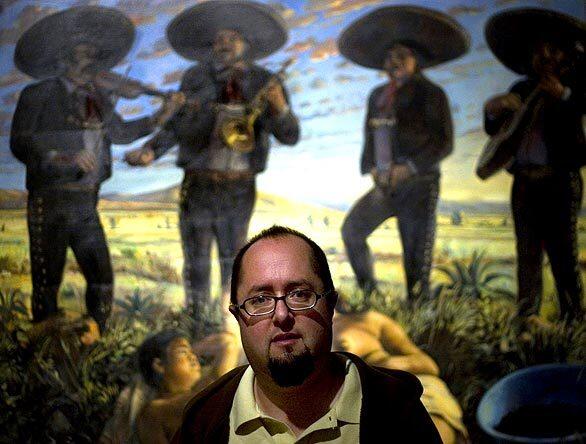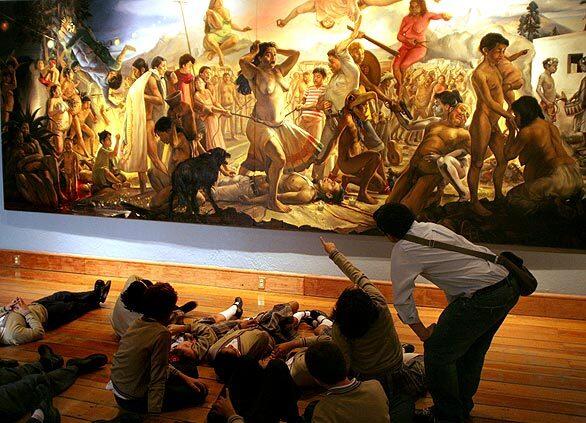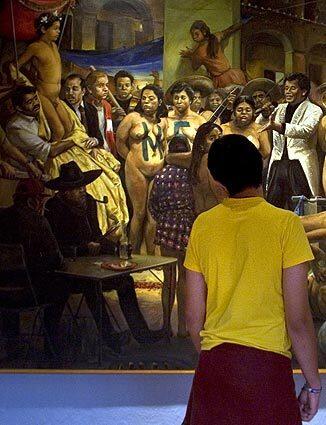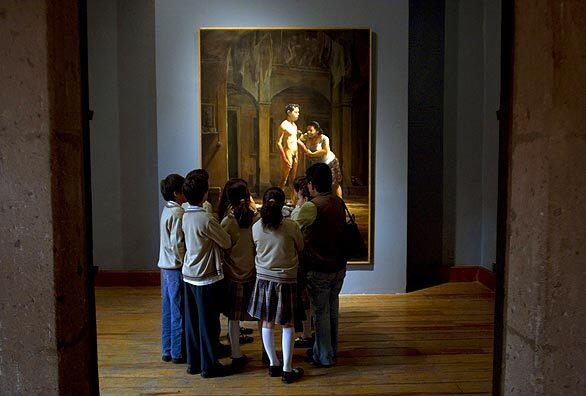Artist Daniel Lezama’s controversial works

Note: Some of the paintings in this Web gallery include images that are explicit in their depiction of nudity and brutal elements of life in Mexico.
Which adjective best fits the work of painter Daniel Lezama? Alluring? Repellent? Classical? Irreverent? Misunderstood? While critics extol his daring and originality, Lezama, 40, makes certain gallery owners squeamish and collectors nervous. His typically large-scale works are imposing in their size and complexity, startling in their frank depictions of frequently nude, mainly working-class Mexicans (including children) engaged in activities that are simultaneously violent and sordid, touching and tender.
Read more about Lezama in Times Staff Writer Reed Johnson recent Sunday Calendar story. What follows is a closer look at Lezama’s work:
Here, the artist poses in front of a painting titled “Amor Eterno,” part of the exhibit “La Madre Prodiga,” showing through the end of June at the Mexico City Museum. Stylistically and thematically, Lezamas art straddles several eras, making some observers regard him as a backward-looking figurative painter, while others see him as a contemporary iconoclast. In truth, hes a thoroughly modern anti-modernist or, as Erick Castillo, curator of the exhibit, has described him, a traditionalist heretic working for the nocturnal legacy of the Mexican unconsciousness. (Sarah Meghan Lee / For The Times)

Art teacher Benjamin Torres discusses with his students the Lezama painting “La Madre Pródiga,” at an exhibit by the same name. The painting, commissioned for the show, is one of Lezamas characteristic provocations about a subject that figures prominently in his art: motherhood. For most Mexicans, motherhood is sacred, reinforced by centuries of social custom and spiritual belief, and symbolized by the Virgin of Guadalupe. For Lezama, motherhood is a more problematic notion. As a painter, he recognizes the pictorial power of the image of the Virgin, supposedly first seen in a vision by the Indian peasant Juan Diego in 1531. In the context of Mexican history, the Virgin has been both a symbol of spiritual salvation and the emblem of the Spaniards conquest of Americas indigenous people. (Sarah Meghan Lee / For The Times)

A visitor to the Mexico City museum studies Lezama’s “La Gran Noche Mexicana,” featuring pop singer Juan Gabriel in the white jacket. (Sarah Meghan Lee / For The Times)

A junior high art class discusses a Lezama painting titled “La Muerte del Tigre de Santa Julia.” “His art, on the one hand its very logical,” said Erick Castillo, curator of the artist’s Mexico City show. “On the other its very uncommon. Many people in the debate think that Daniel is a traditionalist painter, that he is a painter mexicanista. Lezama is among a handful of Mexicos best-known young and middle-age contemporary artists, a group that includes Gabriel Orozco and the ex-pats Melanie Smith and Francis Alÿs. His work has been shown both internationally and in some of Mexicos most important venues, and it addresses some of the most fundamental aspects of Mexican identity and history. (Sarah Meghan Lee / For The Times)







